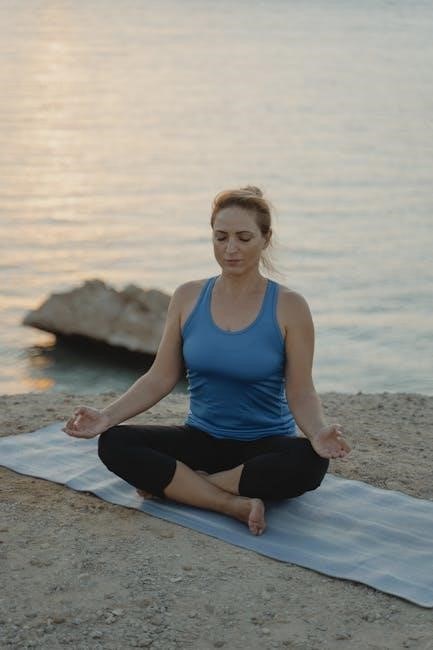Torticollis is a condition characterized by a tilted head due to tight or spasming neck muscles‚ also known as wry neck. It can affect both children and adults‚ often due to congenital factors‚ muscle spasms‚ or poor posture. Exercises are a key component in managing and rehabilitating this condition‚ improving mobility and reducing discomfort.
1.1 What is Torticollis?
Torticollis‚ also known as wry neck‚ is a condition where the head tilts involuntarily due to tight or spasming neck muscles. It can be acute or chronic‚ affecting both children and adults. Causes vary and may include congenital factors‚ muscle spasms‚ or poor posture. Symptoms involve neck pain‚ limited head movement‚ and a visibly tilted head. Diagnosis typically requires a physical exam and possibly imaging tests. Treatment often involves exercises and physical therapy to improve mobility and strength. Understanding the condition and adhering to a consistent exercise routine under professional guidance is crucial for effective management and prevention of recurrence.
1.2 Causes and Risk Factors
Torticollis is often caused by tight or spasming neck muscles‚ which can result from congenital factors‚ muscle imbalances‚ or trauma. Poor posture‚ prolonged sitting‚ or repetitive neck movements are common risk factors. Congenital torticollis may develop in infants due to abnormal fetal positioning or birth trauma. Acquired torticollis can occur at any age‚ often linked to stress‚ injury‚ or underlying medical conditions. Genetic predisposition and weakened neck muscles also increase susceptibility. Understanding these causes and risk factors is essential for tailoring effective exercise routines to address the root of the condition and improve neck alignment and function.
1.3 Symptoms and Diagnosis
Torticollis is characterized by a visible head tilt‚ neck stiffness‚ and difficulty moving the head naturally. Common symptoms include pain or discomfort in the neck‚ limited range of motion‚ and muscle tightness. In infants‚ it may present with a noticeable lump in the neck muscle. Diagnosis typically involves a physical exam to assess neck alignment‚ muscle tone‚ and range of motion. Imaging tests‚ such as X-rays or MRIs‚ may be used to rule out other conditions. Early identification and diagnosis are crucial for implementing effective treatment plans‚ including targeted exercises to improve mobility and reduce discomfort.
Importance of Exercises for Torticollis
Exercises are essential for managing torticollis‚ improving neck mobility‚ and reducing muscle tension. Regular practice enhances flexibility‚ strength‚ and posture while minimizing discomfort and promoting recovery.
2.1 Benefits of Exercise in Managing Torticollis
Exercises for torticollis offer numerous benefits‚ including improved neck flexibility‚ reduced muscle spasms‚ and enhanced posture. Regular practice can alleviate discomfort‚ restore natural head alignment‚ and strengthen neck muscles. By addressing tightness and imbalances‚ exercises help prevent long-term complications and promote overall recovery. They are particularly effective for both children and adults‚ fostering better mobility and reducing the risk of recurring issues. A consistent exercise routine can significantly improve quality of life‚ allowing individuals to perform daily activities with greater ease and confidence. This makes exercises a cornerstone of torticollis management and rehabilitation strategies.
2.2 How Exercises Improve Neck Mobility and Strength
Exercises for torticollis enhance neck mobility by loosening tight muscles and improving joint flexibility. Strengthening exercises target the neck muscles‚ restoring balance and stability. Stretching helps reduce muscle spasms and stiffness‚ while range-of-motion exercises promote fluid movement. Over time‚ these practices improve posture‚ reduce discomfort‚ and enhance overall neck function. Consistent exercise routines can prevent muscle atrophy and improve endurance‚ allowing individuals to perform daily activities with greater ease. Proper technique and gradual progression are key to maximizing benefits and ensuring safe‚ effective rehabilitation of the neck muscles and joints affected by torticollis.
Types of Torticollis Exercises
Stretching‚ strengthening‚ and range-of-motion exercises are essential for managing torticollis. These exercises improve flexibility‚ build muscle strength‚ and enhance neck mobility‚ addressing the condition effectively.
3.1 Stretching Exercises
Stretching exercises are vital for improving flexibility and reducing muscle tightness in torticollis. These exercises target the neck muscles‚ helping to relieve spasms and improve posture. Gentle stretches like the chin tuck and ear-to-shoulder exercises are commonly recommended. The chin tuck involves standing or sitting straight and tucking the chin toward the chest‚ holding for 20-30 seconds. The ear-to-shoulder stretch requires gently bringing the ear toward the shoulder and holding. Regular stretching can enhance range of motion and reduce stiffness‚ making daily activities easier. It’s important to perform these exercises slowly and within a pain-free range to avoid injury.
3.2 Strengthening Exercises
Strengthening exercises are essential for restoring muscle balance and improving posture in individuals with torticollis. These exercises target the neck muscles‚ focusing on building strength and endurance. Resistance exercises‚ such as using a resistance band or light weights‚ can help strengthen the cervical muscles. Isometric exercises‚ where the neck muscles are engaged without movement‚ are also effective. Strengthening the muscles helps improve overall neck stability and reduces the risk of relapse. It’s important to perform these exercises with proper form and gradually increase resistance to avoid strain. Regular practice can lead to better muscle function and long-term relief from symptoms.
3.3 Range-of-Motion Exercises
Range-of-motion exercises are designed to improve neck flexibility and reduce stiffness in individuals with torticollis. These exercises involve gentle movements that guide the head through its natural range of motion‚ such as tilting‚ rotating‚ and nodding. Slow neck rotations and up-and-down movements are common examples. Regular practice helps restore normal movement patterns and alleviates muscle tension. It’s important to perform these exercises smoothly and avoid bouncing or forcing the neck beyond a comfortable range. Over time‚ consistent practice can enhance mobility and reduce the limitations caused by torticollis‚ making daily activities easier and more comfortable.

Stretching Exercises for Torticollis
Stretching exercises for torticollis target tight neck muscles to relieve tension and improve flexibility. Gentle movements like chin tucks and ear-to-shoulder stretches are commonly recommended.
4.1 Chin Tuck Exercise
The chin tuck exercise is a simple yet effective stretch for torticollis. Sit or stand with good posture‚ looking straight ahead. Gently press your chin back toward your chest‚ keeping your head level‚ and hold for 15-30 seconds. Repeat 10-15 times. This exercise helps reduce neck tightness‚ improves posture‚ and relieves muscle spasms. Perform it 2-3 times daily to maximize benefits. It’s a foundational stretch in many torticollis exercise routines‚ often included in downloadable PDF guides for easy reference. Regular practice can enhance neck flexibility and alleviate discomfort associated with torticollis.
4.2 Ear to Shoulder Stretch
The ear to shoulder stretch is another effective exercise for torticollis. Sit or stand with good posture‚ then gently bring your ear toward your shoulder until a stretch is felt on the opposite side of your neck. Hold for 20-30 seconds and repeat 3-5 times on each side. This stretch helps relieve tightness in the sternocleidomastoid muscle‚ a common culprit in torticollis. It’s essential to perform this stretch slowly and without bouncing to avoid injury. Include this exercise in your daily routine‚ as outlined in a torticollis exercise PDF‚ to improve neck flexibility and reduce muscle spasms.
4.3 Side-to-Side Neck Stretch
The side-to-side neck stretch is a simple yet effective exercise for torticollis. Sit or stand with good posture‚ then slowly turn your head to the right‚ bringing your ear toward your shoulder. Hold for 20-30 seconds‚ then return to the starting position. Repeat on the left side. This stretch targets the sternocleidomastoid and scalene muscles‚ helping to relieve tightness and improve range of motion; Perform this exercise 2-3 times daily‚ as outlined in a torticollis exercise PDF‚ to enhance neck flexibility and reduce muscle spasms. Avoid bouncing or forcing your head beyond a comfortable range to prevent strain.
Strengthening Exercises for Torticollis
Strengthening exercises for torticollis focus on improving neck muscle endurance and posture. They often involve resistance and isometric movements to target specific muscle groups‚ aiding in long-term management.
5.1 Resistance Exercises for Neck Muscles
Resistance exercises for neck muscles in torticollis involve using light weights‚ resistance bands‚ or manual resistance to strengthen the neck flexors‚ extensors‚ and rotators. These exercises help improve posture and reduce muscle imbalances. For example‚ patients can perform gentle resistance by placing their hand on their forehead and pressing against it while trying to tilt their head back slowly. Similarly‚ side-to-side resistance exercises can target the sternocleidomastoid muscles. Consistency is key‚ as these exercises gradually build strength and flexibility‚ aiding in long-term management and reducing the risk of relapse. They are often recommended in home exercise programs for effective rehabilitation.
5.2 Isometric Neck Exercises
Isometric neck exercises are a valuable component of torticollis management‚ focusing on strengthening neck muscles without movement. These exercises involve contracting the muscles while keeping the head still. For example‚ patients can gently press their head against their hand while resisting the pressure‚ holding for 5-10 seconds. This helps improve muscle endurance and stability. Isometric exercises are low-risk and can be performed anywhere‚ making them ideal for home exercise programs. They are particularly beneficial for those with limited mobility or pain‚ as they avoid excessive strain on the neck. Regular practice can enhance posture and reduce muscle spasms effectively.

Range-of-Motion Exercises for Torticollis
Range-of-motion exercises for torticollis focus on improving neck flexibility and mobility; These gentle movements help restore normal neck function‚ enhancing both flexibility and overall mobility without strain.
6;1 Slow Neck Rotations
Slow neck rotations are a fundamental range-of-motion exercise for torticollis‚ designed to enhance flexibility and reduce stiffness. Start by sitting or standing with good posture‚ ensuring your shoulders are relaxed. Slowly turn your head to the right‚ bringing your chin toward your shoulder‚ and hold for 5-10 seconds. Then‚ gently rotate your head back to the starting position and repeat on the left side. Perform 5-10 repetitions in each direction. This exercise improves neck mobility and helps alleviate tightness in the cervical muscles. Consistency is key to achieving long-term benefits and preventing further muscle imbalances.
6.2 Up-and-Down Neck Movements
Up-and-down neck movements are a simple yet effective range-of-motion exercise for torticollis. Start by sitting or standing with proper posture‚ ensuring your shoulders are relaxed. Slowly tilt your head forward‚ bringing your chin toward your chest‚ and hold for 5 seconds. Then‚ gently lift your head back to the starting position. Repeat this movement 10-15 times. This exercise helps improve cervical spine flexibility and reduces muscle tightness. Perform it slowly and controlled to avoid strain. Regular practice can enhance neck mobility and alleviate discomfort associated with torticollis‚ making it an essential part of a daily exercise routine.
Creating a Torticollis Exercise Routine
A well-structured exercise routine for torticollis should include stretching‚ strengthening‚ and range-of-motion exercises. Start with gentle movements‚ gradually increasing intensity. A daily plan ensures consistency.
7.1 How to Design a Daily Exercise Plan
Designing a daily exercise plan for torticollis involves tailoring a routine to individual needs. Begin with a warm-up‚ such as gentle neck rolls. Include stretching exercises like the chin tuck and ear-to-shoulder stretch to improve flexibility. Strengthening exercises‚ such as resistance band workouts‚ should follow. Range-of-motion exercises‚ like slow neck rotations‚ help restore mobility. Each session should last 20-30 minutes‚ with breaks to avoid fatigue. Progress gradually by increasing repetitions or resistance. Tracking progress in a journal can help monitor improvements. Ensure exercises are performed smoothly and without pain for optimal results.
7.2 Duration and Frequency of Exercises
The duration and frequency of torticollis exercises should be tailored to individual needs and severity. Typically‚ exercises should be performed 2-3 times daily‚ with each session lasting 15-20 minutes. Start with shorter sessions and gradually increase duration as comfort and strength improve. For children‚ shorter‚ more frequent sessions may be more effective. Adults can aim for longer‚ consistent routines. Consistency is key‚ as stopping too soon may lead to relapse. Adjustments should be made based on progress and discomfort levels‚ ensuring exercises remain effective without causing strain or pain.

Torticollis Exercise PDF Guide
A comprehensive guide providing detailed exercise routines‚ illustrations‚ and instructions for managing torticollis. Accessible and printable‚ it serves as a valuable resource for consistent rehabilitation.
8.1 What to Include in a Torticollis Exercise PDF
A Torticollis Exercise PDF should include detailed descriptions of exercises‚ such as stretching‚ strengthening‚ and range-of-motion activities. It should feature clear instructions‚ diagrams‚ and photos to guide proper form. Including a daily routine schedule and warm-up tips ensures safety and consistency. Progress tracking sheets and modification options for varying skill levels are essential. Safety guidelines and precautions to avoid injury should also be highlighted. The guide should be easy to follow‚ encouraging adherence to the rehabilitation plan and promoting effective management of torticollis symptoms. This comprehensive resource empowers individuals to take an active role in their recovery journey.
8.2 Benefits of Using a Printable Exercise Guide
A printable Torticollis Exercise PDF offers convenience and accessibility‚ allowing individuals to follow structured routines without relying on digital devices. It provides clear‚ visual instructions and diagrams‚ ensuring proper form and technique. Printed guides are portable‚ making it easy to perform exercises at home or while traveling. They also enable users to track progress and stay motivated by marking completed exercises. A well-organized PDF guide can be customized to individual needs‚ promoting consistency and adherence to the rehabilitation plan. This tool supports effective management of Torticollis symptoms and fosters a disciplined approach to recovery.
8.3 Sample Torticollis Exercise Routine in PDF Format
A sample Torticollis Exercise Routine in PDF format provides a structured and organized approach to rehabilitation. It typically includes a variety of exercises‚ such as Chin Tucks‚ Ear to Shoulder stretches‚ and Side-to-Side Neck Stretches‚ each with clear instructions and diagrams. The routine may also outline the recommended duration and frequency of each exercise‚ ensuring consistency and progress. Many PDF guides offer customizable templates‚ allowing users to tailor the routine to their specific needs and track their improvement over time. This format ensures that individuals can follow a comprehensive and effective plan for managing Torticollis symptoms effectively.

Progress Tracking and Safety
Tracking progress in Torticollis exercises involves monitoring improvements in neck mobility and strength while maintaining safety by avoiding overexertion and adhering to prescribed routines.
9.1 How to Track Progress in Torticollis Exercises
Tracking progress in Torticollis exercises involves regular assessment of neck mobility‚ strength‚ and pain levels. Use a journal or PDF guide to document improvements‚ such as increased range of motion or reduced muscle tightness; Measure how consistently exercises are performed and note any changes in posture or discomfort. Set realistic benchmarks‚ like achieving a certain number of repetitions or holding stretches longer. Monitor how often exercises are done and if there’s an increase in the number of sets or intensity. If pain increases‚ stop and consult a healthcare professional. Adjust routines based on progress and maintain consistent effort for optimal results.
9.2 Safety Guidelines for Performing Torticollis Exercises
When performing Torticollis exercises‚ prioritize safety to avoid injury or worsening symptoms. Always consult a healthcare professional before starting any new routine. Warm up with gentle movements to prepare muscles. Avoid bouncing or forcing stretches beyond a comfortable range. Use proper posture and technique to prevent strain. If pain occurs‚ stop the exercise immediately. Modify exercises to suit individual tolerance and progress gradually. Ensure the exercise area is clear of hazards. Stay hydrated and rest if dizziness or discomfort arises. Seek professional guidance if symptoms persist or worsen during the program.
Consistency is key to managing Torticollis. Regular exercises improve mobility‚ reduce discomfort‚ and promote long-term relief. Download a Torticollis exercise PDF guide for structured routines and better outcomes.
10.1 Summary of Key Points
10.2 Encouragement to Continue Exercise Routine
Commitment to a Torticollis exercise routine is key to achieving lasting relief and improved mobility. Celebrate small victories‚ as progress may be gradual. Each exercise session brings you closer to better posture‚ reduced stiffness‚ and enhanced comfort. Remember‚ consistency is more important than intensity. Even small efforts contribute to long-term improvement. Use the Torticollis exercise PDF guide as a helpful resource to stay motivated and track your journey. Encourage yourself to persist‚ knowing that patience and dedication will lead to meaningful results. Every stretch and movement is a step toward a healthier‚ pain-free lifestyle.